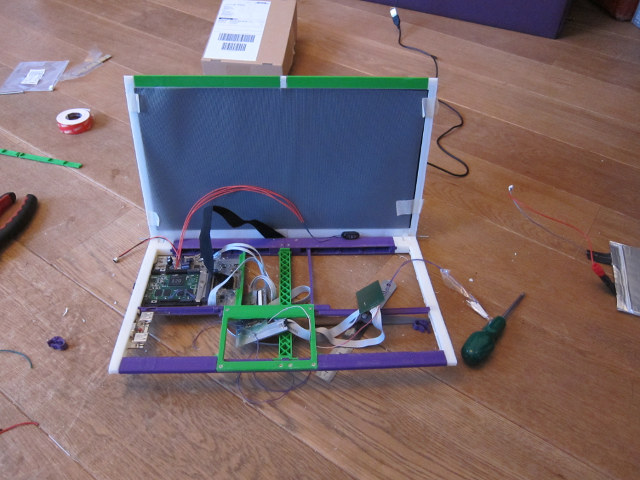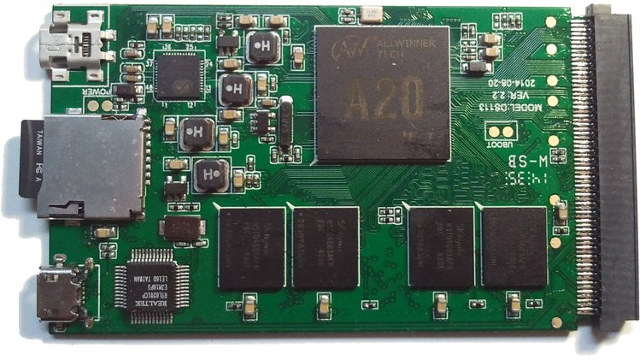When the first Raspberry Pi model launched, there was just not enough boards to fill the demand, and as people kept waiting they were also investigating alternatives, and a growing community worked on Allwinner based platforms. At the time (2012), the main hardware project was EOMA68 CPU card using a PCMCIA connector, with ended up inside Improv development board, and aimed at providing user replaceable and upgradeable CPU cards. Sadly the initiative got some issues, and things did not quite work out as expected, but the person who launched the whole project, Luke Kenneth Casson Leighton (LKCL), did not give up on the idea, and has kept on working on EOMA68 standard with CPU cards from Allwinner and other SoC vendors. Recently, he’s been working on a Libre Laptop based on an Allwinner A20 EOMA68 CPU module, and will showcase the prototype at FOSDEM 2016 in Brussels this coming week-end.

Key (preliminary) hardware features of the laptop:
- User-upgradeable EOMA68 CPU Card (currently based on Allwinner A20)
- Storage – microSD card slot
- Display
- 15.6″ 1366×768 LCD
- 4.3″ capacitive touch panel with backlit LCD used as a trackpad
- Keyboard – Full-sized Chicony OEM keyboard with number pad
- USB – 1x external full-sized USB Port, 2x internal full-sized USB Ports (for WiFi, 3G, Bluetooth, Storage…)
- Battery – 10000mAh battery providing 6 to 8 hours of battery power (For some reasons, that’s an e-Bike battery)

The Libre laptop will run (mostly) open source software, hence the name, and the prototype has already been shown to boot Linux. If you want to learn more about the design, Luke go through some of the 25 3D printed pieces required, and explains some of the issues he had to solve in the video below. The laptop panels will be made of Bamboo apparently…
You can follow the progress of the project on Rhombus Tech Laptop 15″ news page, as well as on ARM Netbooks mailing list.

Jean-Luc started CNX Software in 2010 as a part-time endeavor, before quitting his job as a software engineering manager, and starting to write daily news, and reviews full time later in 2011.
Support CNX Software! Donate via cryptocurrencies, become a Patron on Patreon, or purchase goods on Amazon or Aliexpress






“4.3″ capacitive touch panel with backlit LCD used as a trackpad” => could have user-definable virtual keys on (rather large) trackpad…
Nice 🙂 Olimex are working on something similar. I saw first prototypes of their DIY laptop in December.
@Leon
True, and they also have a talk at FOSDEM for A64-OlinuXino board and their DIY laptop.
cool but it really needs a SATA port or similar rather than just USB 2 to properly fill ‘laptop’ rather than tablet+keyboard.
development is nice, but will it reach to market.
rhombus has been working on that for a long long time, since with the A10, and has yet to make any wave in the market place. and now to make matter worse, we have move to quadcore as the current market standard and going to 64bit as standard soon enough.
i was excited then, now its like “meh”. IMO it probably wont even reach mass production………
@milkboy
They have plans to launch a crowdfunding campaign: https://www.crowdsupply.com/eoma68
Maybe not for the laptop… They wrote “microdesktop”. We’ll see.
He’s managed to get a short talk at FOSDEM 2016 -> https://fosdem.org/2016/schedule/event/libre_hardware/
@onebir
or play games on it, or actually have a scrollbar (you ever manage to actually use the “scroll” function of synaptics trackpads??) or display battery life (even if the main laptop’s switched off) or… anything you can imagine. the firmware is GPLv3+ so you can literally do anything you like.
@milkboy
the nice thing about a modular design is that the main CPU card doesn’t matter, it can always be upgraded… *without* the environmental impact of a total redesign of the entire product range. i am talking to intel (about their latest SoC that’s also being used by the up-board.org team), and to allwinner to resolve the non-distributable issues with the boot0 bootloader program for the A64, and so on. i had to work for 4 years and make some tough decisions during that time, to change the EOMA68 interface (throwing away 2 revisions of products in the process) because this is a *long-term* standard, not a “let’s get it to market and make as much money as possible as quickly as possible” standard. basically once these first products are out, things will move very quickly.
@M
this is a totally different market. read the eco-computing whitepaper which emphasises the “good enough” aspect – http://rhombus-tech.net/whitepapers/ecocomputing_07sep2015/
the idea is not to make the absolute absolute fastest competitive product with standard laptops: we’ve seen enough environmental damage caused by the mainstream manufacturer’s strategy. the idea is to use low-cost mass-volume processors, package them into a re-useable form-factor so that they stay out of landfill, and to create upgradeable user-repairable products that *also* stay out of landfill.
to do that, it became necessary to use the lowest-common-denominator interfaces of SoCs and allow for upgradeability in the future. that’s why EOMA68 has USB 3.1 (10gbit/sec) which, when there are common SoCs with that in the near future, SATA will look very out-dated.
the next laptop that i make will have a SATA port (USB-to-SATA) **BUT**, here’s the thing: the power budget will have to increase by an extra 5-7 watts to cope with it. that immediately takes the Power PCB out of the “15W single cell” realm and into “20-25 Watt double or triple cell” territory.
… can you see where this is going?
… by the time you start to reach 25 watts, that immediately says “a fan is needed”. now you’ve not only increased the complexity of the design, but you’ve also put it into “cascading complexity” where the additional complexity results in yet more complexity – thermal management and design, which now requires completely different materials (i can’t use PLA because that has a glass point of 60 Centigrade….)
so does that help you to understand why, for this *first revision* laptop – for this *first* laptop product in the series – i have stayed away from complexity and kept it simple? i want to actually deliver a product, and that means i need to make sure it’s achievable on a reasonable budget. after all, if it’s complex, it’s costly, and that in and of itself means that it’s environmentally costly. for an eco-conscious product range, i can’t justify that.
Casing complete @ http://rhombus-tech.net/community_ideas/laptop_15in/news/EOMA68_Libre_15.6in_Laptop_casework_completed/
@cnxsoft
If plastic is bamboo colour, it’ll look great 🙂
Also wonder if the trackpad position could be customisable (eg for lefties)?
@cnxsoft
Thanks for the info… btw.
In case you are in contact with Luke Kenneth Casson Leighton: it would be nice to see a video of that thing actually booting AND working… (i have seen the video he made before but that was still just ‘lose parts’)